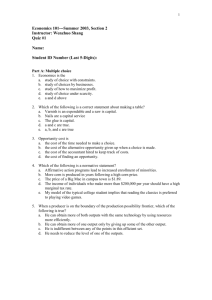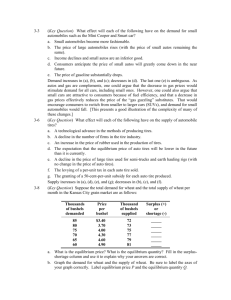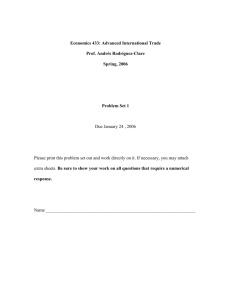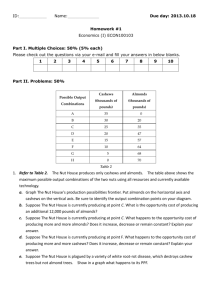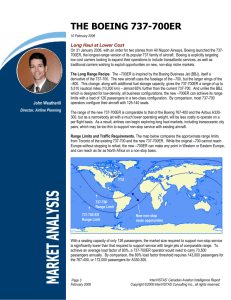Welcome to Econ 1 - Bakersfield College
advertisement
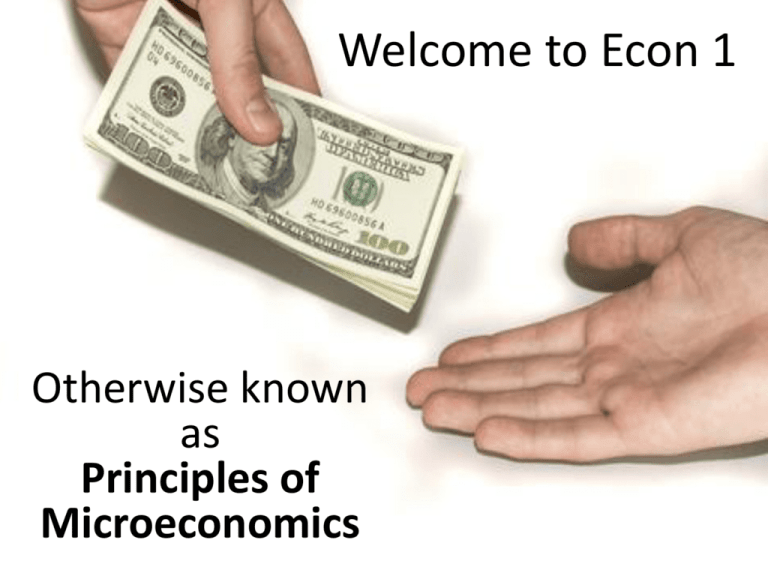
Welcome to Econ 1 Otherwise known as Principles of Microeconomics Why is Economics worth your valuable time and money to learn? Why is Economics worth your valuable time and money to learn? What is economics about? What is the definition of economics? We only learned one thing today …. Economics is the study of how a society allocates scarce resources to satisfy unlimited wants. So you have no excuse not to know it. Welcome to Day 2 Principles of Microeconomics Quiz today? Magic 8 ball says …. Write your name, class day and time, and Quiz #1 at the top of your paper. Define Economics Your answer should start “Economics is the study of …” This question is worth 2 points. And what’s the answer? 1. The definition of economics: How a society allocates scarce resources to satisfy unlimited wants. Because of scarcity, everything has an opportunity cost. Opportunity cost is the best alternative given up when a choice is made. Sometimes the opportunity cost is represented by money. What do you want for your 40 bucks? or Sometimes the opportunity cost is not money. Often it is time. or or Sometimes it is even the chance of your death. 99.9999% .0001% The world as economists see it is one of continually comparing costs versus benefits. Should you go to college? What is the opportunity cost of taking this class? Tuition = $46 X 3 units = $138 Textbook = $100 Tuition + textbooks = $238 Is this the full cost? Don’t forget time! or or Let’s assume 50 hours in class and 50 hours study time over the next 15 weeks that could be spent on a minimum wage job. 100 hours at $8 an hour = $800 dollars income given up by choosing to take this class. The biggest cost for most of you for coming to Bakersfield College is the value of your time given up. Tuition and textbooks = $178 Time = $800 Total cost = $978 Is this class worth $978? If college tuition and textbooks were free, could everyone afford to go? Tuition - Free Textbooks - Free Rent - ? Food - ? Clothes - ? Assume you either start working at a full –time minimum wage job at age 19 or get an A.A. and start working at a job that pays 20% more at age 21. Also assume $5,000 in tuition/textbook costs. How long until college pays for it self? 19 yrs old 21 yrs old 24 yrs old 29 yrs old 34 yrs old H.S. Dip $0 $32,000 $80,000 $160,000 $240,000 A.A $0 -$5,000 $52,600 $148,600 $244,600 Getting an A.A. pays for itself by the early 30s. What about a B.A.? Cal State Bakersfield estimates $6,682 a year tuition and fees and let’s say $4,000 in textbooks over the 4 years. Total costs to get the B.A. = $30,728. Assume a B.A. recipient makes 60% more. 19 yrs old 23 yrs old 29 yrs old 34 yrs old H.S. Dip B.A. $0 $0 $64,000 -$30,728 $160,000 $122,872 $240,000 $250,872 Again, college pays for itself in the early 30s. 57% of Americans 25 and over have some college and 41% have an A.A. or higher. We are split down the middle between college and noncollege people. What factors affect if someone goes to college or not? Study abroad at Virginia Tech … Tai Gui Le! - Kristen Mankosa “In the US, when you see a price tag, end of story. In China, price tags can be just the beginning. Here are my 5 best tips on how to score the biggest deals… 1. Never act excited. 2. Cut the price in half, then half it again. 3. You’re not stealing their money. 4. Don’t be afraid to walk away. 5. Shop Around.” A partner in a top Wall Street law firm can charge $1000 an hour = $16.67 a minute. Does he really want to stand around arguing over his taxi fare? Wages Per Minute Top Wall Street lawyer = $16.67 American average = $0.36 Mexican Average = $0.05 Chinese Average = $0.045 What do Americans bargain over? Coupons are America’s bargaining. The same opportunity cost reasoning explains why people may turn down “free” money by not picking up a penny. Even when human life is at stake? What should the speed limit be? Gas and lives saved benefits versus additional time on the road loss. Source – Seat Belt Laws and Why We Should Keep Them, Richard Alsop, etc. Sometimes you can trade money for time. That’s what scalpers are for. Get the VIP Treatment At Disneyland “Our hosts booked the Premium VIP Tour ($295 per hour; $275 in the off-season), which includes “limited expedited boarding.” Guests who book the Premium VIP tour can use the Fastpass entrance at every attraction that offers that service, and have "preferred access" to more than a dozen other attractions …” Rich Manhattan moms hire handicapped tour guides so kids can cut lines at Disney World – May 14, 2013 They are 1 percenters who are 100 percent despicable. Some wealthy Manhattan moms have figured out a way to cut the long lines at Disney World — by hiring disabled people to pose as family members so they and their kids can jump to the front, The Post has learned. The “black-market Disney guides” run $130 an hour, or $1,040 for an eighthour day “My daughter waited one minute to get on ‘It’s a Small World’ — the other kids had to wait 2 1/2 hours,” crowed one mom, who hired a disabled guide through Dream Tours Florida. “You can’t go to Disney without a tour concierge,’’ she sniffed. “This is how the 1 percent does Disney.” The woman said she hired a Dream Tours guide to escort her, her husband and their 1-year-old son and 5-yearold daughter through the park in a motorized scooter with a “handicapped” sign on it. The group was sent straight to an auxiliary entrance at the front of each attraction. Disney allows each guest who needs a wheelchair or motorized scooter to bring up to six guests to a “more convenient entrance.” Ryan Clement runs Dream Tours Florida with girlfriend Jacie Christiano, whom the rich Manhattan mom indicated was her family’s guide. A working phone number for Christiano couldn’t be found, and Clement refused to put The Post through to her. A message left on Facebook was not immediately returned by Christian. Clement denied that his gal pal uses her disability to bypass lines. He said she has an auto-immune disorder and acknowledged that she uses a scooter on the job. Disney did not return repeated requests for comment.” What we learned today. 1. Opportunity cost is the best alternative given up when a choice is made. 2. Economists both explain and advise human behavior by comparing benefits to costs. 3. Opportunity costs can include money, time, chance of death, effort, or just general unpleasantness. 4. Examples of decisions that can’t be properly understood without understanding opportunity cost are going to college, speed limit laws, why some country’s shoppers bargain more, and behavior at Disneyland. Homework 1. Know the definition of opportunity cost. 2. Understand how it applies to the examples discussed in class. 3. Read all of chapter 1 in the textbook. Welcome to Day 3 Principles of Microeconomics Quiz today? Magic 8 ball says …. Building Our First Model The Production Possibilities Frontier Model or PPF Model How much can we produce from our four factors of production? 1. Labor 2. Machines and Factories - Capital 3. Natural resources 4. Technology Suppose the only two things we know how to make are bushels of wheat and aircraft carriers. Point A B C D E Carriers 4 3 2 1 0 Wheat 0 10,000 20,000 30,000 40,000 What is the opportunity cost of the first aircraft carrier? … Of the second carrier? … Of two carriers? Point A B C D E Carriers 4 3 2 1 0 Wheat 0 10,000 20,000 30,000 40,000 Production Possibilities Frontier Diagram 4.5 A Aircraft Carriers 4 3.5 B 3 C 2.5 2 D 1.5 1 E 0.5 0 0 10000 20000 30000 Bushels of Wheat 40000 50000 Production Possibilities Frontier Diagram 4.5 A Aircraft Carriers 4 3.5 B 3 C 2.5 2 D 1.5 1 E 0.5 0 0 10000 20000 30000 Bushels of Wheat 40000 50000 PPF Diagram lines always slope down because the opportunity cost of producing more of one thing is producing less of something else. But are they always straight lines? You are the ruler of a kingdom of 4 people. These 4 people can make 2 things for you: butter and calculators. Amy Bart Carla David Calculators 5 5 3 2 Butter (lbs) 12 3 5 2 If you want 5 calculators made, who is the best person/people to transfer? Transfer Amy and get 5 calculators for 12 pounds of butter lost. Transfer Bart and get 5 calculators for 3 pounds of butter lost. Transfer Carla and David together and get 5 calculators for 7 pounds of butter lost. Calculators Butter Amy Bart Carla David 5 5 3 2 12 3 5 2 Lbs butter lost per calculator (lbs) gained 12/5 = 2.4 3/5 = 0.6 5/3 = 1.67 2/2 = 1.0 What is the best order to move these people from butter to calculator production? Comparative Advantage The situation in which a person or economy has a lower opportunity cost of producing a good than other potential producers. Production Possibilities Frontier Diagram 16 A 14 Calculators 12 B 10 C 8 6 D 4 2 E 0 0 5 10 15 Pounds of Butter 20 25 You are the ruler of a country that makes wheat and aircraft carriers. Who is the best type of person to transfer from farming to ship building? A lawyer can type faster than her secretary. Should she type her own letters? The Law of Increasing Opportunity Cost The more of a good already being produced, the greater the cost of making one more. All PPF diagrams have PPF lines that slope down. PPF diagrams with increasing opportunity cost have PPF lines that bow out. This is the default case for this class. Production Possibilities Frontier Diagram 4.5 Aircraft Carriers 4 A B 3.5 3 2.5 C 2 D 1.5 1 0.5 E 0 0 5000 10000 15000 20000 25000 30000 35000 40000 45000 Bushels of Wheat Can we be at point Z? 4.5 Aircraft Carriers 4 A B 3.5 3 2.5 C 2 Z 1.5 1 0.5 D E 0 0 5000 10000 15000 20000 25000 30000 35000 40000 45000 Bushels of Wheat Can we be at point Z? Yes – Two Ways 1. Unemployed resources (macroeconomics) 2. Inefficient use of resources (microeconomics) Building a carrier in Maine by ship builders costs 3,000 bushels of wheat given up. That moves us from point E to D. Building a carrier in Kansas by farmers costs 20,000 bushels of wheat. That is the move from B to A. If we build our first carrier in Kansas by farmers, we go from point E to Z. 4.5 A Aircraft Carriers 4 B 3.5 3 C 2.5 2 1.5 Z 1 0.5 D E 0 0 5000 10000 15000 20000 25000 30000 35000 40000 45000 Bushels of Wheat An economy is producing efficiently when it is impossible to make more of one thing without making less of something else. An economy is producing inefficiently when it is possible to make more of one thing without making less of something else. Two simple rules: 1. All efficient points are on the PPF line. 2. All inefficient points are inside/under the PPF line. Production efficiency is achieved when maximum advantage is taken of specialization in resource use. Specialization is using resources to produce the good in which they have a comparative advantage. The textbook mentions the comparative advantage the U.S. has with Hong Kong in agriculture. We sell them $1,912 million worth of nuts, meat, and fruit. They sell us $11 million worth of snack foods (including chocolate). Are efficient points necessarily better than inefficient ones? 4.5 A Aircraft Carriers 4 B 3.5 3 C 2.5 2 1.5 Z 1 0.5 D E 0 0 5000 10000 15000 20000 25000 30000 35000 40000 45000 Bushels of Wheat Points B, C, and D are necessarily better than point Z. Points A and E may be better, but also may be worse. 1. Not every efficient point is necessarily better than every inefficient point. 2. For every inefficient point, there are always some efficient points that are better. To know which points have to be better than Z, draw a line straight up and straight out. All points in the “piece of pie” have to be better. 4.5 A Aircraft Carriers 4 B 3.5 3 C 2.5 2 1.5 Z 1 0.5 D E 0 0 5000 10000 15000 20000 25000 30000 35000 40000 45000 Bushels of Wheat Remember positive statements and normative statements from your readings in chapter 1? Positive statements are factual statements. Normative ones are value judgments. 1. C has more stuff than Z. 2. More stuff is better. 3. Therefore, C is better than Z. Is more stuff better? Buddha - "If a man has conquered greed nothing can limit his freedom.“ "There is no fire like greed." Jesus - "It is easier for a camel to go through the eye of a needle than for a rich man to enter the kingdom of God." "For the love of money is the root of all evil."
